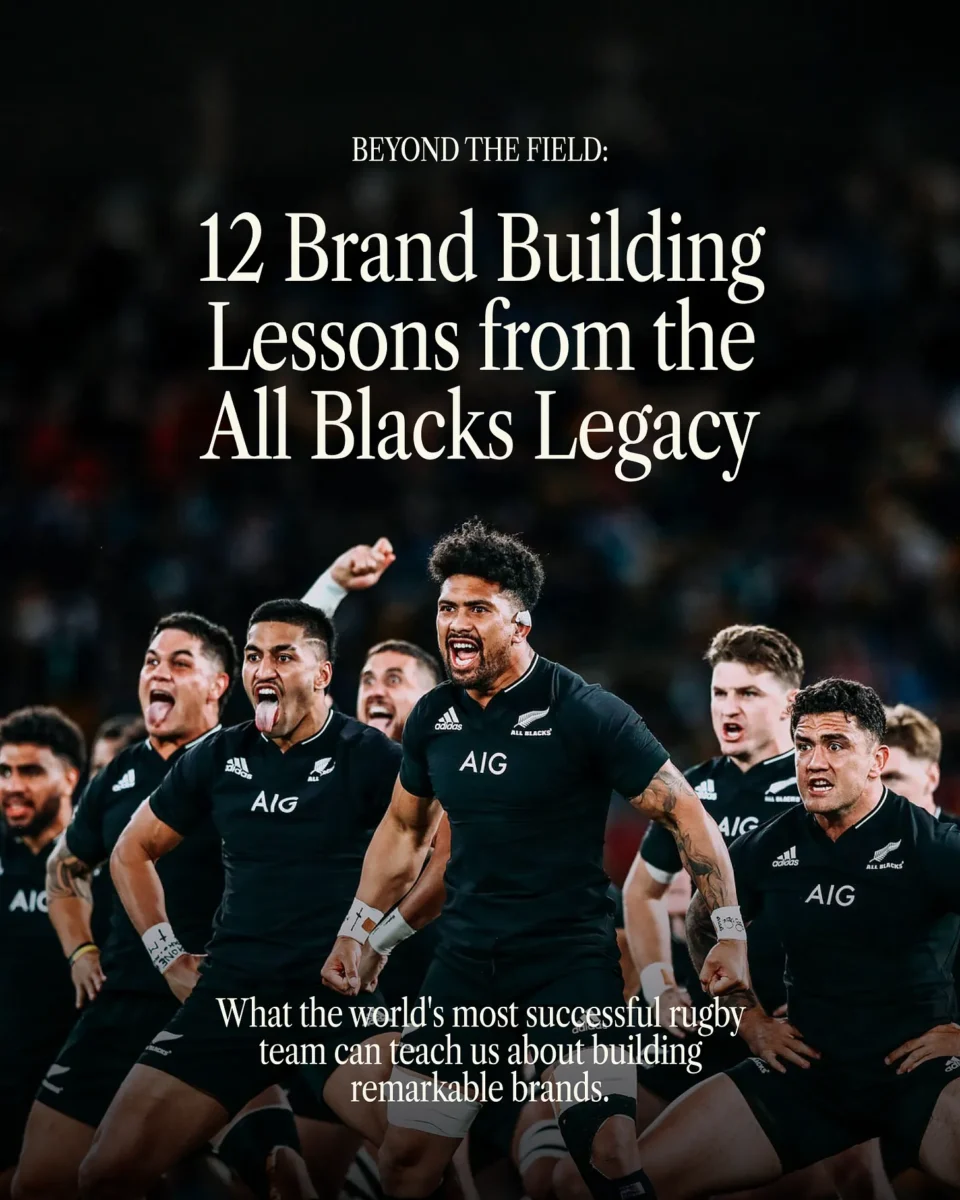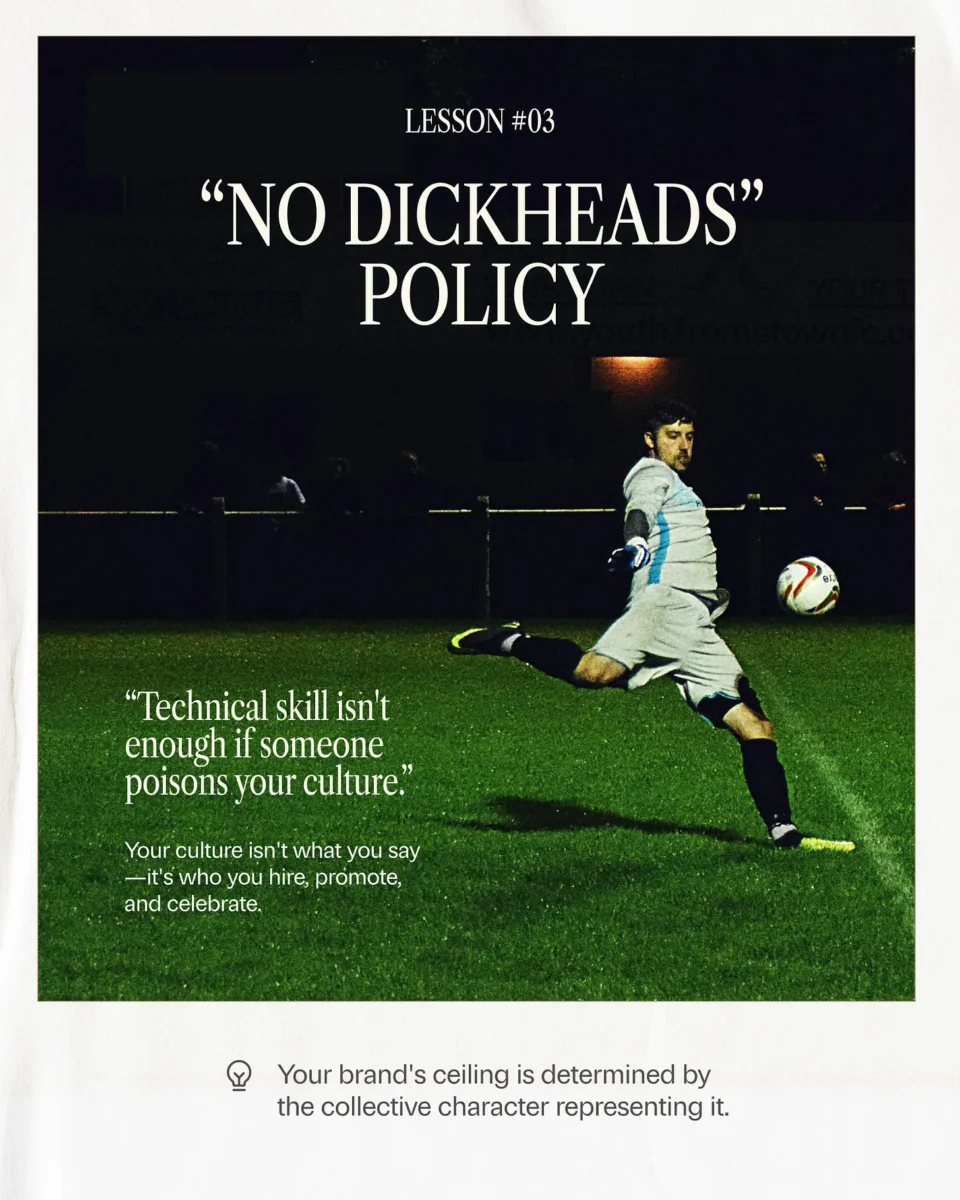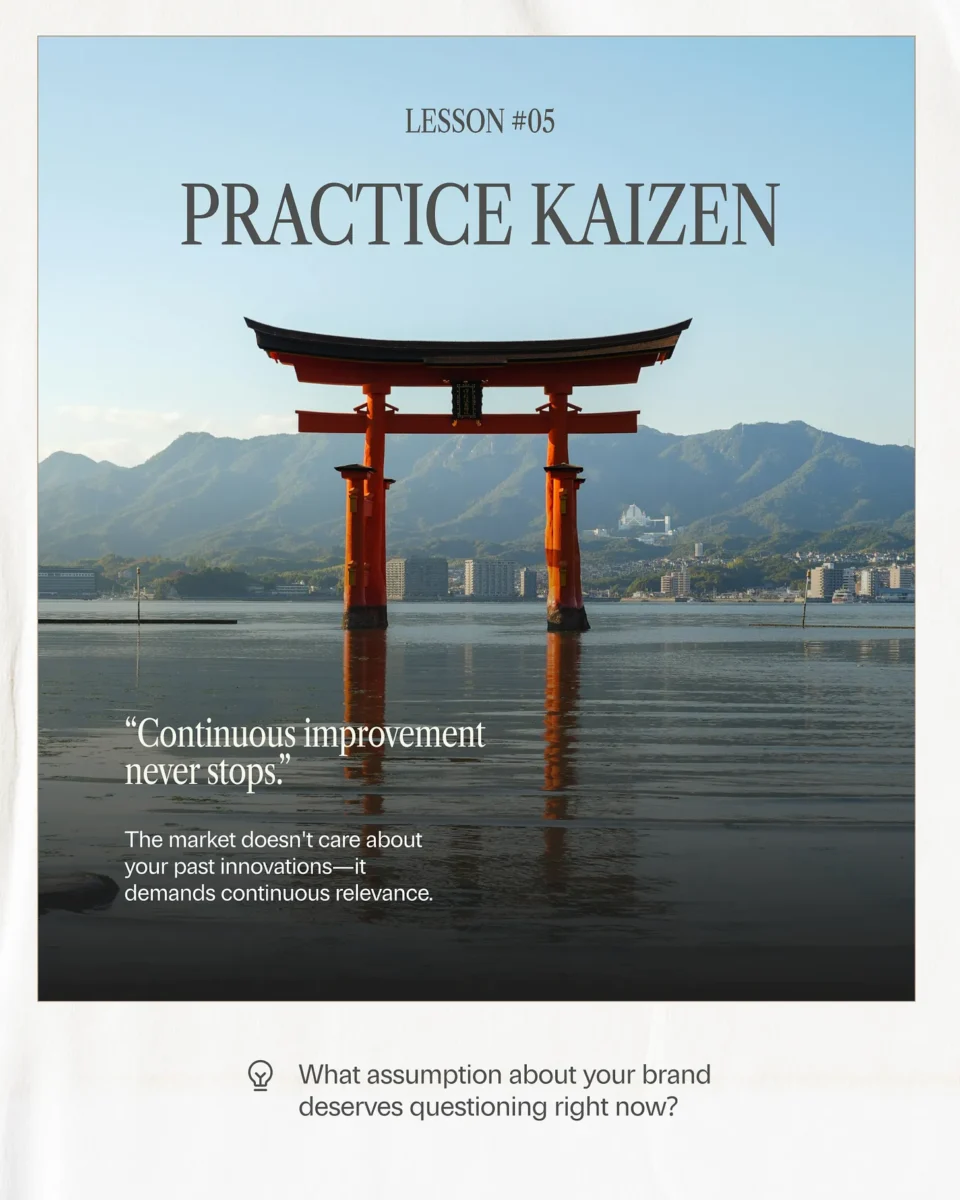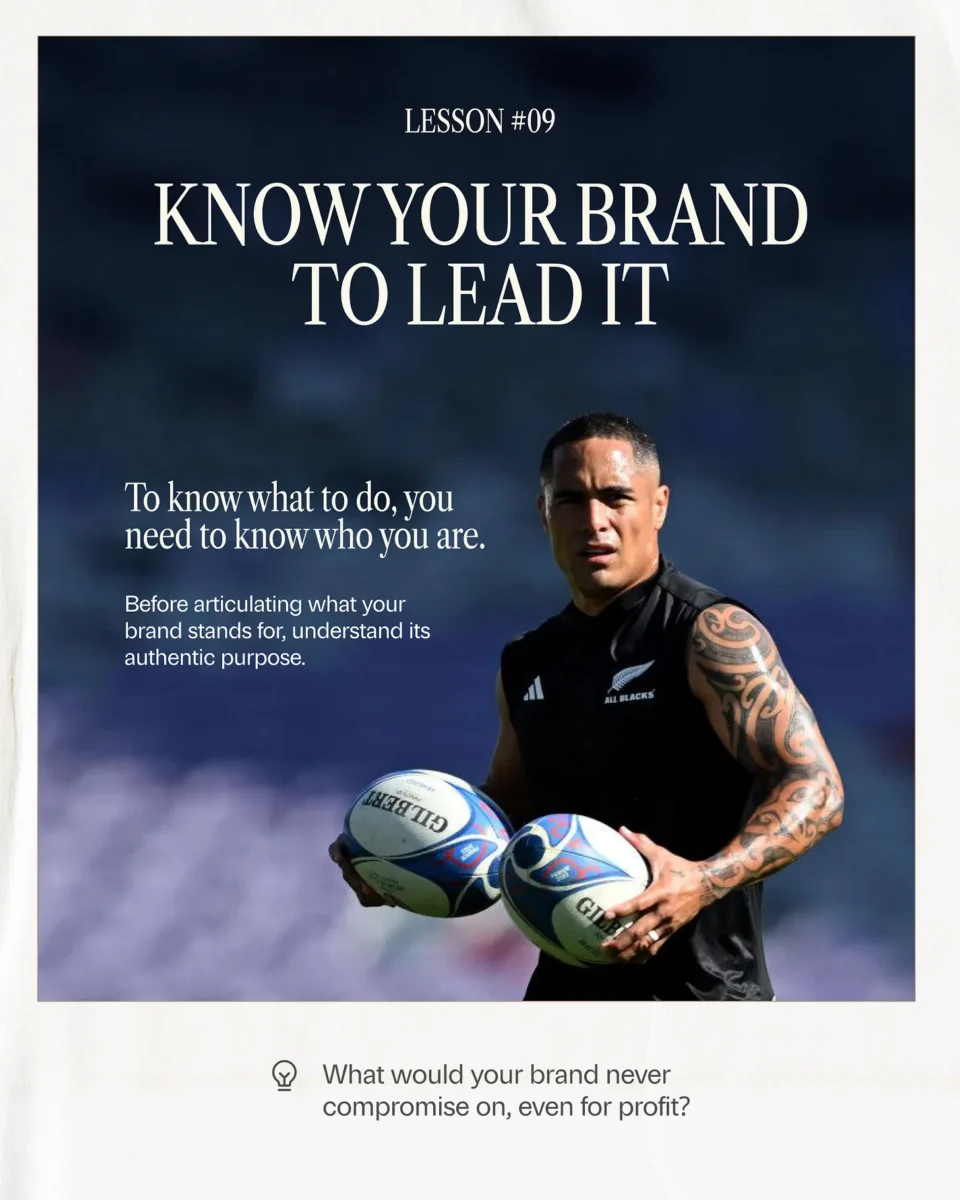I recently finished James Kerr’s book “Legacy,” which explores the culture and philosophy behind New Zealand’s legendary rugby team, the All Blacks. This book is a MUST read on so many levels. At its core, this is a leadership book, that brands and business owners can learn so much from. Below are my 12 core takeaways from the book to help you level up your brand.

1. Leave Your Brand in a Better Place
The All Blacks live by this principle: “Leave the jersey in a better place than you found it.” Each player understands they’re temporary stewards of something much greater than themselves.
For your brand: Ask yourself not just “How can I grow my business?” but “How am I elevating my entire category?” The brands that disrupt industries don’t just take market share—they expand the market’s imagination of what’s possible.
When Patagonia pledged to “save our home planet” or when Airbnb reimagined hospitality, they weren’t just building companies—they were leaving their industries better than they found them.
Action step: Identify one industry norm you could challenge that would benefit your customers and competitors alike. What constructive disruption could be part of your legacy?Subscribe
2. Ubuntu: Your Brand Ecosystem
The All Blacks embrace “Ubuntu”—”I am because we are.” This African philosophy recognizes our fundamental interconnectedness.
For your brand: Your brand isn’t a monologue; it’s a conversation. It exists in the ecosystem of your team, customers, suppliers, and even competitors. The most resilient brands understand they’re co-created within a community.
This is why customer communities have become such powerful brand assets—LEGO Ideas, Sephora’s Beauty Insider, or Peloton’s leaderboards. These aren’t marketing tactics; they’re recognition that “I am because we are.”
Action step: Map your brand ecosystem. Beyond customers, who contributes to your brand’s strength? How are you nurturing these relationships rather than just extracting value from them?

3. “No Dickheads”: The Culture Behind the Brand
One of the All Blacks’ most straightforward recruitment rules is refreshingly blunt: “No dickheads.” Technical skill alone doesn’t qualify someone if they undermine team culture.
For your brand: Your culture isn’t what you say—it’s who you hire, promote, and celebrate. I’ve watched brilliant but toxic hires poison brand cultures from within, creating disconnects between external promises and internal reality.
Zappos famously offers new employees $2,000 to quit after their training period—a small price to pay to identify those who aren’t culturally aligned. Your brand’s ceiling is determined by the collective character of the people representing it.
Action step: What’s your version of the “no dickheads” rule? How might you more explicitly screen for cultural contribution, not just capability?
4. Sweeping the Sheds: Brand Experience Is in the Details
After matches, even legendary All Blacks “sweep the sheds”—cleaning their locker room. No task is beneath them; no detail is too small.
For your brand: Your customer experience is only as strong as its weakest touchpoint. The brands we admire obsess over details others ignore.
Consider the unboxing experience of Apple products—the paper quality, the pull tab placement, even the subtle resistance when you lift the lid. Or how Trader Joe’s cashiers make eye contact and engage in genuine conversation. These “shed-sweeping” moments reveal your true standards.
Action step: Identify three customer touchpoints where your brand experience is merely adequate. How could you transform them into signature moments that reflect your highest standards?

5. Kaizen: Brand Evolution Never Stops
The All Blacks embrace “Kaizen”—continuous improvement—understanding that yesterday’s excellence guarantees nothing tomorrow.
For your brand: The market doesn’t care about your past innovations or awards. It demands continuous relevance. Yet many brand owners fall in love with their initial success formula, becoming prisoners of their early positioning.
Consider Netflix’s evolution from DVD-by-mail to streaming to content creation. Each transformation wasn’t reactive—it was preemptive evolution before their current model became obsolete.
Action step: What assumption about your brand deserves questioning? What evolution might your customers need before they even realize it?
6. The Pebble in Your Brand Experience
Muhammad Ali said, “It’s not the mountains ahead that wear you down, it’s the pebble in your shoe.” The All Blacks meticulously eliminate small irritations that might impede performance.
For your brand: Often it’s not major flaws that erode customer loyalty but small, repeated frustrations. What are the “pebbles” in your customer experience?
Amazon’s relentless focus on removing friction—from 1-Click ordering to frustration-free packaging—demonstrates how eliminating small annoyances can create massive competitive advantage.
Action step: Survey your most loyal customers about their small frustrations with your brand. What minor irritation, if fixed, might dramatically improve retention?
7. The Art of Strategic Brand Focus
The All Blacks understand that high performance requires saying no to distractions. As Steve Jobs noted: “People think focus means saying yes to the thing you’ve got to focus on… It means saying no to the hundred other good ideas.”
For your brand: The strongest brands aren’t defined by what they do, but by what they refuse to do. They understand that clarity comes from elimination, not addition.
When Starbucks removed breakfast sandwiches because their smell interfered with coffee aroma, or when In-N-Out Burger maintained its focused menu despite expansion opportunities, they demonstrated that strategic refusal builds stronger brands than opportunistic growth.
Action step: What “good opportunity” should your brand say no to? What offering or feature might you eliminate to strengthen your core identity?
8. Keep a Blue Head: Leadership Under Pressure
Under pressure, the All Blacks distinguish between a “red head” state (panicked, scattered, reactive) and a “blue head” state (clear, focused, responsive).
For your brand: Market disruptions, negative publicity, or competitor moves will test your leadership. The difference between brands that emerge stronger from challenges versus those that unravel is often this “blue head” capacity.
When JetBlue faced an ice storm crisis that stranded passengers, CEO David Neeleman’s “blue head” response—including a public Customer Bill of Rights and personal apologies—transformed potential disaster into a defining moment of brand character.
Action step: Develop your crisis “pre-mortem.” What potential challenge might reveal your brand’s character, and how would a “blue head” response differ from a “red head” reaction?

9. Know Your Brand to Lead Your Brand
The All Blacks have a saying: “In order to know what to do, you need to know who you are.”
For your brand: Before you can articulate what your brand stands for, you must understand its authentic purpose. Many brands try to reverse-engineer purpose from market demand rather than building from genuine identity.
Patagonia doesn’t struggle with strategic decisions because their identity is crystal clear. When they encouraged customers to “Don’t Buy This Jacket,” it wasn’t a marketing stunt but an authentic expression of who they are.
Action step: If your brand were a person with complete self-knowledge, what would it never compromise on, even for profit? What would it be willing to be fired for believing in?
10. The Italian Proverb: Make Your Brand Worth Your Life
“The king and the pawn go back in the same box.” This Italian proverb reminds us that we’re all giving our lives for something.
For your brand: Building a brand demands immense personal investment. The question isn’t whether your brand is profitable, but whether it’s worthy of the life you’re pouring into it.
What makes the difference between entrepreneurs who eventually resent their “successful” businesses versus those who find lasting fulfillment isn’t usually financial outcomes—it’s alignment between personal values and brand expression.
Action step: If you were at the end of your career looking back, what would make you proudest about your brand’s impact? How might that long-term perspective change your current priorities?
11. Sing Your Brand Into Existence
There’s a beautiful Māori saying: “Let your ears listen. Invite your own language. Sing your world into existence.”
For your brand: Your brand is the world you create through consistent language, experiences, and actions. You literally sing it into existence through every decision and communication.
This is why brand consistency isn’t just a marketing principle—it’s how you make your vision real. Each touchpoint either reinforces or undermines the world you’re trying to create.
Action step: What’s one brand communication element (visual, verbal, experiential) that doesn’t fully align with your vision? How might you bring it into harmony with the world you’re trying to sing into existence?
12. Be a Good Brand Ancestor
Perhaps the most profound concept from the All Blacks culture is their focus on being “good ancestors”—making decisions that benefit future generations.
For your brand: Your brand exists not just to generate value today but to create something that outlasts you. The question isn’t whether you’re successful by quarterly metrics, but whether you’re building something that deserves to endure.
When REI closed on Black Friday for #OptOutside or when CVS stopped selling tobacco products despite the $2 billion revenue loss, they weren’t making quarterly decisions—they were making generational ones.
Action step: What’s one decision you could make today that might reduce short-term results but would make your brand a better ancestor to future generations?
The Pattern of Brand Excellence
What fascinates me about these principles is how universally they apply. Whether building a legendary rugby team or an enduring brand, excellence follows consistent patterns.
The real secret may be that brand greatness isn’t complicated—it’s simply uncommon. It requires embracing timeless principles that most understand but few consistently practice.
So I ask you: How will you leave your brand better than you found it? What will your legacy be?
What principle from the All Blacks most resonates with your brand journey? I’d love to hear your thoughts in the comments below.
P.S. My social media masterclass is now live. In this course, I teach you my secrets on how to get ahead on social media– the same framework I use with the biggest brands, influencers and creators. Head to Camille-moore.com to access.